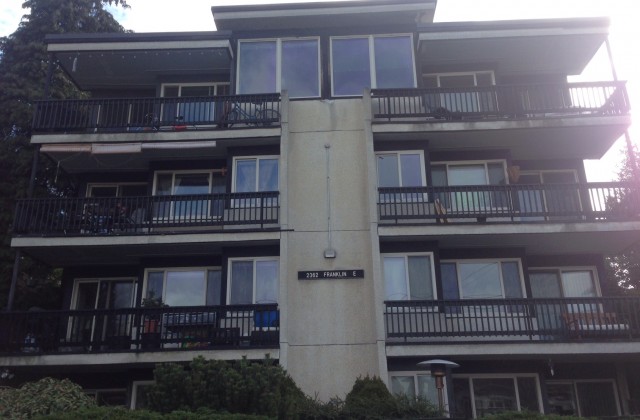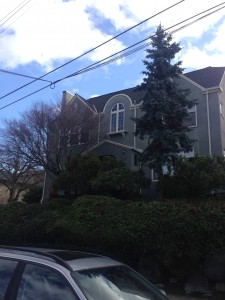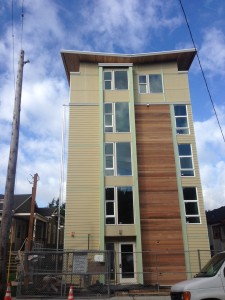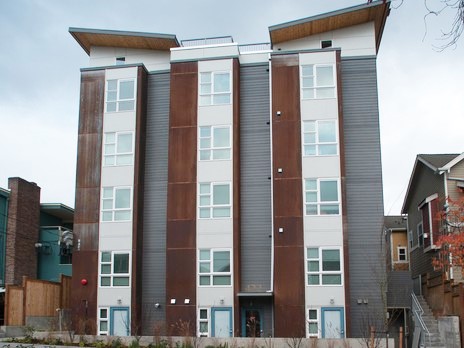Tonight on KIRO Radio: Out of Scale? Look Across the Street!
Tonight at 7:30 I’ll be on the Jason Rantz Show broadcast on KIRO FM, 97.3 to respond to this morning’s story on microhousing. I’ll be pointing out that the microhousing being built in Eastlake is completely in scale with everything else in the neighborhood. See for yourself what the neighborhood looks like in the pictures below.
Update: KIRO has posted the segment that aired online. Our portion starts at about minute 15:00.
The truth is the building fits right in with what’s already on the block and is an addition that will make it possible for more people to live in the neighborhood, shop and eat at local businesses, and easily get to and from work on transit.
Have Any Red Herrings? KIRO is Buying Them!
Once again local media—this time KIRO Radio—has played right into the NIMBYs hands with a story on this morning’s radio and a post on their website. The headline?
Microhousing trend in Seattle ruining property values, warns real estate agent
I talked with the producer of the story Zak Burns and took him to task for his reporting. It’s really the cheap way out, telling the story of poor, set upon neighbors facing an onslaught of microhousing development.
First, he never bothered to contact anyone on the other side including the developer or anyone who has been on the record supporting this. His source was one real estate agent with an interest in the neighborhood and Dennis Saxman a growth opponent who filed an appeal of microhousing legislation that was tossed out by the hearing examiner. I told Mr. Burns, next time please give us a chance to give our side of the story.
Second, and probably worst of all, Burns simply went out to the neighborhood and took pictures of the microhousing project completely out of context. Lynn Thompson of the Times has done this as well, having a photographer lie down on the ground to photograph a “monster house” without bothering to look at what was across the street.
Fortunately, Publicola ran a post just a couple days ago showing exactly what the street looks like and putting the project in context.
Lastly, I asked Mr. Burns to show me any hard evidence that microhousing as any effect on property values. I reminded him that these people’s property values are already higher than single-family zones because they can sell their land for a higher return—it’s zoned for multifamily use. These neighbors already have a big value advantage because potential buyers can do more with the land.
Reporters, journalists, and bloggers of any persuasion on this issue do themselves and the city a big disservice when they selectively photograph development projects without bothering to look across the street. And they don’t help debate when they buy crates full of red herrings fished up by angry neighbors who don’t want change.
Unfortunately the myth becomes reality, and City Council starts to believe that microhousing projects have “bad design” or are “out of scale.” Remember, microhousing can only be built in zones where there is already significant numbers of multifamily housing.
Hopefully, next time, Mr. Burns will take pictures of what’s on the other side of the street and give us a call.
Curtailing Small-Lots, and Ride Share. What’s Next? Who Knows?
On Monday the Seattle City Council took steps to limit the operations of ride sharing companies in Seattle. The public’s reaction has generally been one of confusion and outright derision: why would the Council curtail an innovative idea for helping people get from point A to point B without having to use their own car? In fact, for many people, the ride share idea is a reason not to have a car at all. Isn’t this what we want as a city, innovative ways of getting around more sustainably? The Council’s imposition of limits on innovative transportation solutions isn’t new and they’ve done the same thing with housing.
Back in 2012 the City Council declared an emergency because local builders were using an innovative strategies to build new housing in single-family neighborhoods. At the time here’s what I wrote:
Instead of highlighting these small-lot houses as really awesome feats of architecture, engineering, and free market capitalism the Council goes into emergency mode. Why? Because the benefits of developing this new housing is “accruing to developers who are familiar with arcane historic property and tax records.” Imagine that. Get knowledge of the code and tax records and use it to create housing and some extra cash (and some jobs) and that’s a bad thing. Shame on you for knowing arcane things! Only DPD and central staff should know arcane things. Didn’t you get the memo?!
Imagine the idea of shutting something down to protect people who already have a franchise in the face of growing demand and doing it because the new people, the innovators, have unique knowledge. The country is watching us and wondering what’s their problem?
I’ve been accused of having Hayekian reveries and I guess I am having another one. Friedrich Von Hayek is often ridiculed by progressives because he was a champion of the market place. But because the Council keeps making such bad decisions, Seattle’s ideological veneer is beginning to crack and Hayek may not sound so strange anymore to people who want better ideas for meeting our city’s challenges. Here’s a wedge to open those cracks wider. Here’s Hayek from a seminal article on knowledge in the market place:
Practically every individual has some advantage over all others because he possesses unique information of which beneficial use might be made, but of which use can be made only if the decisions depending on it are left to him or are made with his active coöperation. We need to remember only how much we have to learn in any occupation after we have completed our theoretical training, how big a part of our working life we spend learning particular jobs, and how valuable an asset in all walks of life is knowledge of people, of local conditions, and of special circumstances. To know of and put to use a machine not fully employed, or somebody’s skill which could be better utilized, or to be aware of a surplus stock which can be drawn upon during an interruption of supplies, is socially quite as useful as the knowledge of better alternative techniques. And the shipper who earns his living from using otherwise empty or half-filled journeys of tramp-steamers, or the estate agent whose whole knowledge is almost exclusively one of temporary opportunities, or the arbitrageur who gains from local differences of commodity prices, are all performing eminently useful functions based on special knowledge of circumstances of the fleeting moment not known to others.
Hayek’s point is the no one person (or 9 persons and their staff) can possibly know everything there is to know about transportation or housing in Seattle. When we regulate something we take the chance that our regulation could have negative effects but we do it to protect some basic right or to ensure that someone doesn’t get harmed. The harm to one group must be weighed against the benefits to the other group. There is no safe level of exposure to second hand smoke, for example, and therefore prohibiting smoking in places where others are exposed is an easy decision to make.
However, the Council seems to think that it can manage every decision a person might make in reading the land use code and prevent them from finding a way to build a new housing unit, or two, or 100. Somehow the Council wants to be sure that nobody find a way to do something that it hadn’t thought of first. Everything must go according to plan and the programming in the code or it must be stopped.
Council action this week sends the message to innovators and people who have ideas about how to make our city work better to go somewhere else. But it’s people using their brains and what they know that can provide the market place with innovations that create better products that cost less and are more efficient, something that can’t be planned or regulated into existence.That’s exactly what we need and want. And when someone finds a way to do something good that wasn’t in the rules we should celebrate that.
In the case of ride sharing it’s clear that the limits imposed on ride sharing companies is completely arbitrary and bears absolutely no relationship to the demand for the services. Furthermore, the expectation from Council that ride sharing companies share all their data is tantamount to the City becoming an owner or manager of the companies; if they want to control ride share companies they ought to become investors and share some of the risk too.
The same is true of new housing development. The Council seems to want to manage every aspect of new development (even the numbers of sinks in microhousing), taxing it, and determining how much return investors should get. What’s their risk from trying to micromanage private businesses? Perhaps not getting reelected is a risk that they need to factor into their political pro forma.
Seattle Speaks Up: A Poster Boy for Neighborhood Overreach?
Hello Councilmember O’Brien,
I wanted to alert you to the latest efforts to claim that microhousing is out of scale with surrounding buildings.
As you said, neighbors often point out what they call “bad buildings” as the basis for their opposition to this product. But please see the attached e-mail thread about a project at 2371 Franklin in Eastlake. They want a “poster boy” and here it is:
“We at SSU are finally getting around to addressing some of the messages from Eastlake folks about the monster project at 2371 Franklin Ave East, which is very close to your home.”
Monster? Really?
Here’s the building across the street
I’m pointing this out because taken out of context these kinds of claims by the neighborhood can be misleading and downright dishonest. This is often (if not always) the argument for restrictions and design review.
The building is a great building and will house 39 people sustainably for years to come; and there was only one house there before that was falling down.
This is exactly why we’re skeptical of exposing these projects to design review, and we hope that when neighbors say that a project is “bad” that you and Council staff will take the time to appreciate the context of the project.
Sincerely,
Roger Valdez
Keep Microhousing Prices Low and Fix Design Review
We’ve been engaging the Council and opponents of microhousing for almost a year now and there is still strong support for microhousing as an important choice for people looking for a place to live in Seattle. But the efforts of opponents to scuttle microhousing continue and some on the City Council feel like they need to do something to assuage the fears of the opposition. That something might be design review, and the Council needs to know that subjecting microhousing to design review won’t solve their angry neighbor problem and it will put microhousing out of reach for some when prices go up. Here’s a letter we sent Mike O’Brien reiterating our position. Let him know what you think too by sending him an e-mail.
We are asking that design review not be imposed on microhousing projects unless and until there are significant improvements made to design review.
There is almost universal sentiment that the current system of design review—including so-called Streamline Design Review—is broken. The process is open-ended, too costly, and has no impact on the concerns surfaced by neighbors. Design review has no effect on parking, for example.
Even City staff has made the observation that after going through the design review process “projects showed little evidence of substantial modification” (see page 3 of the report written by DPD at http://clerk.seattle.gov/~public/meetingrecords/2013/plus20130628_4b.pdf).
City staff also refuted charges (in the SEPA appeal) that pending legislation would lead to more microhousing by testifying that the legislation would have a slowing effect on the supply of units because of “the addition of design review requirements.” If the Council wants to drive up the cost of a housing choice currently within reach of many people in the City, imposing design review would do just that.
Adding costs to microhousing with no benefits hurts people looking for housing, and design review should be a useful, predictable, and less costly process for all new projects throughout the city.










